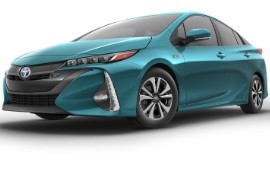TOYOTA Prius Prime Models/Series Timeline, Specifications & Photos
First production year: 2016
Engines: Hybrid
Body style: Hatchback
Toyota made another step towards its electrification program and introduced the plug-in hybrid version of the Prius in 2016, a vehicle that, from the automaker’s point of view, could solve the dilemma between a hybrid and a battery-electric vehicle.
When Toyota introduced the Prius on the market in 1997, it surprised the world. Still, the first generation of this nameplate didn’t last too long and was replaced by a second generation in 2003. That model was the one that gave the world the much-needed answer for long-range, low emissions and minimal running costs. Over the years, other automakers caught up and introduced their hybrids or plug-in hybrids, and Toyota was the only major player that didn’t have a PHEV in its lineup. As a result, its engineers burned the midnight oil and delivered a solution. After Toyota launched the fourth generation of the Prius in 2015, it unveiled the Prius Prime at the 2016 New York Auto Show.
The Japanese automaker tried to make a clear distinction between its models, the Prius and the Prius Prime. Even if the vehicles shared the same TNGA platform and had a similar shape, some details differentiated them. At the front, for instance, the Prime featured slim LED headlights with four distinct blocks and corner-mounted blinkers. In addition, the automaker added daytime running lights on the bumper, with a tall and slim design. Moreover, the car’s front fascia was also altered and included a redesigned grille, which was mostly blocked to improve aerodynamics. From its profile, the car offered the same look as its hybrid sibling. It featured sculptured door panels and an ascending belt line and ended at the back of the vehicle with a short trunk and a lip spoiler. A particular detail about this vehicle was on the rear quarter panels. While the Prius featured one fuel flap on the left side of the vehicle, the Prime had two, one on each side. One was for the fuel, and the other was to charge the batteries.
Inside, the automaker offered customers an 11.6” portrait-mod touchscreen for the infotainment unit. The comfortable front seats were available with either cloth or man-made leather upholstery. Like on the previous generations of the Prius, the Prime version featured an instrument cluster placed in the middle of the dashboard, on top of it, above the infotainment screen. In addition, customers could order the car with a full-color head-up display. In the back, the larger battery pack of the vehicle didn’t affect the passenger area, so they had the same legroom and headroom as in the regular Prius.
Under the hood was the same 1.8-liter Atkinson gasoline engine that powered the front wheels via an eCVT transmission. In addition, the car had a larger, 8.8 kWh battery pack that customers could recharge at home in 5h30’ at a regular 110-volt power outlet. Those living in countries with a 220-volt grid could do that in half the time, 2h45,’ respectively.
